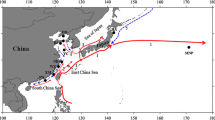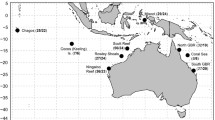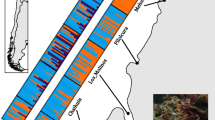Abstract
There is considerable interest in the processes that generate genetic divergence in marine species and the spatial and temporal scales over which these processes operate. Shark Bay, a large embayment (~13,000 km2) on the arid west coast of Australia, has been described as a focal point for genetic divergence in marine species due to its heterogeneous environment. This study represents the first DNA-based analysis of the genetic structure of a marine species with pelagic early life stages (ELS) in this region. Twelve microsatellite loci were used to compare the genetic composition of the teleost Chrysophrys auratus from five areas within Shark Bay, and from near-by shelf waters approximately 250 km to the south. The results suggest that the microsatellite composition of C. auratus is homogeneous across most of Shark Bay and near-by shelf waters. This genetic homogeneity is probably maintained via small amounts of contemporary gene flow, which may reduce the potential for C. auratus to locally adapt to the Shark Bay environment. A weakly differentiated assemblage in Freycinet Estuary in the Western Gulf of Shark Bay provided an important exception to the otherwise homogeneous microsatellite composition of C. auratus in the study area. This weak differentiation probably reflects restrictions to gene flow into and/or out of this site due to the temporal isolation of breeding adults, selective mortality of immigrants and/or the presence of hydrological barriers to larval transport. Each of these factors can be linked to environmental heterogeneity in Shark Bay.



Similar content being viewed by others
References
Bastow T, Jackson G, Edmonds J (2002) Elevated salinity and isotopic composition of fish otolith carbonate: stock delineation of pink snapper, Pagrus auratus, in Shark Bay, Western Australia. Mar Biol 141:801–806. doi:10.1007/s00227-002-0884-8
Bekkevold D, André C, Dahlgren TG, Clausen LA, Torstensen E, Mosegaard H, Carvalho GR, Christensen TB, Norlinder E, Ruzzante DE (2005) Environmental correlates of population differentiation in Atlantic herring. Evolution 59:2656–2668. doi:10.1554/05-183.1
Bossart J, Prowell DP (1998) Genetic estimates of population structure and gene flow: limitations, lessons and new directions. Trends Ecol Evol 13:202–206. doi:10.1016/S0169-5347(97)01284-6
Bradbury IR, Campana SE, Bentzen P (2008) Low genetic connectivity in an estuarine fish with pelagic larvae. Can J Fish Aquat Sci 65:147–158. doi:10.1139/Fo7-154
Broquet T, Viard F, Yearsley JM (2013) Genetic drift and collective dispersal can result in chaotic genetic patchiness. Evolution 67:1660–1675. doi:10.1111/j.1558-5646.2012.01826.x
Burford MO, Larson RJ (2007) Genetic heterogeneity in a single year-class from a panmictic population of adult blue rockfish (Sebastes mystinus). Mar Biol 151:451–465. doi:10.1007/s00227-006-0475-1
Burling MC, Pattiaratchi CB, Ivey GN (2003) The tidal regime of Shark Bay, Western Australia. Estuar Coast Shelf Sci 57:725–735. doi:10.1016/s0272-7714(02)00343-8
Chistiakov DA, Hellemans B, Volckaert FA (2006) Microsatellites and their genomic distribution, evolution, function and applications: a review with special reference to fish genetics. Aquaculture 255:1–29. doi:10.1016/j.aquaculture.2005.11.031
Christensen J, Jackson G (2014) Shark Bay snapper: science, policy, and the decline and recovery of a marine recreational fishery. In: Christensen J, Tull M (eds) Historical perspectives of fisheries exploitation in the indo-Pacific. Springer, Netherlands, pp 251–268
Clarke K, Gorley R (2006) User manual/tutorial. Primer-E Ltd, Plymouth: 93
Compton TJ, Morrison MA, Leathwick JR, Carbines GD (2012) Ontogenetic habitat associations of a demersal fish species, Pagrus auratus, identified using boosted regression trees. Mar Ecol Prog Ser 462:219–230. doi:10.3354/meps09790
Coutin P, Cashmore S, Sivakumuran K (2003) Assessment of the snapper fishery in Victoria. Marine and freshwater resources institute, Queenscliff. Project no. 97/127. Fisheries Research and Development Corporation, Canberra, Australia
Crawford NG (2010) SMOGD: software for the measurement of genetic diversity. Mol Ecol Resour 10:556–557. doi:10.1111/j.1755-0998.2009.02801.x
Cunningham KM, Canino MF, Spies IB, Hauser L (2009) Genetic isolation by distance and localized fjord population structure in Pacific cod (Gadus macrocephalus): limited effective dispersal in the northeastern Pacific Ocean. Can J Fish Aquat Sci 66:153–166. doi:10.1139/F08-199
Earl DA, vonHoldt BM (2012) STRUCTURE HARVESTER: a website and program for visualizing STRUCTURE output and implementing the Evanno method. Conserv Genet Resour 4:359–361. doi:10.1007/s12686-011-9548-7
Edmonds J, Moran M, Caputi N, Morita M (1989) Trace element analysis of fish Sagittae as an aid to stock identifications: pink snapper (Chrysophrys auratus) in western Australian waters. Can J Fish Aquat Sci 46:50–54. doi:10.1139/f89-007
Edmonds J, Steckis R, Moran M, Caputi N, Morita M (1999) Stock delineation of pink snapper and tailor from Western Australia by analysis of stable isotope and strontium/calcium ratios in otolith carbonate. J Fish Biol 55:243–259. doi:10.1111/j.1095-8649.1999.tb00676.x
Fairclough D, Edmonds J, Jackson G, Lenanton R, Kemp J, Molony B, Keay I, Crisafulli B, Wakefield C (2013) A comparison of the stock structures of two exploited demersal teleosts, employing complementary methods of otolith element analysis. J Exp Mar Biol Ecol 439:181–195. doi:10.1016/j.jembe.2012.10.023
Féral JP (2002) How useful are the genetic markers in attempts to understand and manage marine biodiversity? J Exp Mar Biol Ecol 268:121–145. doi:10.1016/S0022-0981(01)00382-3
Foll M (2012) BayeScan v2. 1 user manual. Ecology 20:1450–1462
Forester BR, Jones MR, Joost S, Landguth EL, Lasky JR (2016) Detecting spatial genetic signatures of local adaptation in heterogeneous landscapes. Mol Ecol 25:104–120. doi:10.1111/mec.13476
Francis MP (1994) Duration of larval and spawning periods in Pagrus auratus (Sparidae) determined from otolith daily increments. Environ Biol Fish 39:137–152. doi:10.1007/BF00004931
Friedman M (1937) The use of ranks to avoid the assumption of normality implicit in the analysis of variance. J Am Stat Assoc 32:675–701. doi:10.1080/01621459.1937.10503522
Galarza JA, Carreras-Carbonell J, Macpherson E, Pascual M, Roques S, Turner GF, Rico C (2009) The influence of oceanographic fronts and early-life-history traits on connectivity among littoral fish species. Proc Natl Acad Sci U S A 106:1473–1478. doi:10.1073/pnas.0806804106
Gardner MJ, Chaplin JA, Shaw KM (2011) Development and characterisation of novel microsatellite loci for the baldchin groper (Choerodon rubescens) and cross-amplification in seven other labrid species. Conserv Genet Resour 3:461–466. doi:10.1007/s12686-010-9379-y
Gardner MJ, Chaplin JA, Phillips NM (2014) Isolation and characterisation of novel microsatellite markers from Pagrus auratus and cross amplification in Acanthopagrus butcheri. Conserv Genet Resour 6:155–157. doi:10.1007/s12686-013-0031-5
Gardner MJ, Chaplin JA, Potter IC, Fairclough DV (2015) Pelagic early life stages promote connectivity in the demersal labrid Choerodon rubescens. J Exp Mar Biol Ecol 472:142–150. doi:10.1016/j.jembe.2015.07.007
Gartner-Kepkay K, Zouros E, Dickie L, Freeman K (1983) Genetic differentiation in the face of gene flow: a study of mussel populations from a single Nova Scotian embayment. Can J Fish Aquat Sci 40:443–451. doi:10.1139/f83-063
Goudet J (2002) FSTAT v. 2.9. 3.2 Lausanne, Switzerland: University of Lausanne. Available on the internet. http://www2.unil.ch/popgen/softwares/fstat.htm
Hauser L, Carvalho GR (2008) Paradigm shifts in marine fisheries genetics: ugly hypotheses slain by beautiful facts. Fish Fish 9:333–362. doi:10.1111/j.1467-2979.2008.00299.x
Hedgecock D (1986) Is gene flow from pelagic larval dispersal important in the adaptation and evolution of marine invertebrates? Bull Mar Sci 39:550–564
Hedrick PW (1986) Genetic polymorphism in heterogeneous environments: a decade later. Annu Rev Ecol Syst 17:535–566. doi:10.1146/annurev.es.17.110186.002535
Hendry AP, Day T (2005) Population structure attributable to reproductive time: isolation by time and adaptation by time. Mol Ecol 14:901–916. doi:10.1111/j.1365-294X.2005.02480.x
Hetzel Y, Pattiaratchi C, Lowe R (2013) Intermittent dense water outflows under variable tidal forcing in Shark Bay, Western Australia. Cont Shelf Res 66:36–48. doi:10.1016/j.csr.2013.06.015
Hetzel Y, Pattiaratchi C, Lowe R, Hofmeister R (2015) Wind and tidal mixing controls on stratification and dense water outflows in a large hypersaline bay. J Geophys Res Ocean 120:6034–6056. doi:10.1002/2015JC010733
Jackson G, Cheng YW (2001) Parameter estimation with egg production surveys to estimate snapper, Pagrus auratus, biomass in Shark Bay, Western Australia. J Agric Biol Environ Stat 6:243–257. doi:10.1198/108571101750524580
Jackson G, Moran M (2012) Recovery of inner Shark Bay snapper (Pagrus auratus) stocks: relevant research and adaptive recreational fisheries management in a world heritage property. Mar Freshw Res 63:1180–1190
Jackson G, Norriss JV, Mackie MC, Hall NG (2010) Spatial variation in life history characteristics of snapper (Pagrus auratus) within Shark Bay, Western Australia. N Z J Mar Freshw Res 44:1–15. doi:10.1080/00288331003641646
Johnson MS, Black R (1990) Genetic divergence of venerid clams in Shark Bay. In: Berry P, Bradshaw SD, Wilson BR (eds) Research in Shark Bay. Western Australian Museum, Perth, pp 159–168
Johnson M, Black R (1998) Effects of isolation by distance and geographical discontinuity on genetic subdivision of Littoraria cingulata. Mar Biol 132:295–303. doi:10.1007/s002270050395
Johnson MS, Creagh S, Moran M (1986) Genetic subdivison of stocks of snapper, Chrysophrys unicolor, in Shark Bay, Western Australia. Mar Freshw Res 37:337–345
Jost L (2008) GST and its relatives do not measure differentiation. Mol Ecol 17:4015–4026. doi:10.1111/j.1365-294X.2008.03887
Knutsen H, Olsen EM, Jorde PE, Espeland SH, André C, Stenseth NC (2011) Are low but statistically significant levels of genetic differentiation in marine fishes ‘biologically meaningful’? A case study of coastal Atlantic cod. Mol Ecol 20:768–783. doi:10.1111/j.1365-294X.2010.04979
Kuparinen A, Merilä J (2007) Detecting and managing fisheries-induced evolution. Trends Ecol Evol 22:652–659
Lacson J, Riccardi V, Calhoun S, Morizot D (1989) Genetic differentiation of bicolor damselfish (Eupomacentrus partitus) populations in the Florida keys. Mar Biol 103:445–451. doi:10.1007/BF00399576
Le Corre N, Johnson LE, Smith GK, Guichard F (2015) Patterns and scales of connectivity: temporal stability and variation within a marine metapopulation. Ecology 96:2245–2256. doi:10.1890/14-2126.1
Lemaire C, Allegrucci G, Naciri M, Bahri-Sfar L, Kara H, Bonhomme F (2000) Do discrepancies between microsatellite and allozyme variation reveal differential selection between sea and lagoon in the sea bass (Dicentrarchus labrax)? Mol Ecol 9:457–467. doi:10.1046/j.1365-294x.2000.00884.x
Lenormand T (2002) Gene flow and the limits to natural selection. Trends Ecol Evol 17:183–189. doi:10.1016/S0169-5347(02)02497-7
Limborg MT, Helyar SJ, de Bruyn M, Taylor MI, Nielsen EE, Ogden R, Carvalho GR, Bekkevold D (2012) Environmental selection on transcriptome-derived SNPs in a high gene flow marine fish, the Atlantic herring (Clupea harengus). Mol Ecol 21:3686–3703. doi:10.1111/j.1365-294X.2012.05639.x
Logan BW, Cebulski DE (1970) Sedimentary environments of Shark Bay, Western Australia. In: Logan BW, Davies GR, Read JF, Cebulski DE (eds) Carbonate sedimentation and environments, Shark Bay, Western Australia. The American Association of Petroleum Geologists, Oklahoma, pp 1–37
MacDonald CM (1980) Population structure, biochemical adaptation and systematics in temperate marine fishes of the genera Arripis and Chrysophrys (Pisces: Perciformes), Australia. PhD Thesis, Australian National University
Meirmans PG, Van Tienderen PH (2004) GENOTYPE and GENODIVE: two programs for the analysis of genetic diversity of asexual organisms. Mol Ecol Notes 4:792–794. doi:10.1111/j.1471-8286.2004.00770.x
Moberg P, Burton R (2000) Genetic heterogeneity among adult and recruit red sea urchins, Strongylocentrotus franciscanus. Mar Biol 136:773–784
Moran M, Burton C, Caputi N (1999) Sexual and local variation in head morphology of snapper, Pagrus auratus, Sparidae, in the Shark Bay region of Western Australia. Mar Freshw Res 50:27–34. doi:10.1007/s002270000281
Moran M, Burton C, Jenke J (2003) Long-term movement patterns of continental shelf and inner gulf snapper (Pagrus auratus, Sparidae) from tagging in the Shark Bay region of Western Australia. Mar Freshw Res 54:913–922. doi:10.1071/MF03012
Munguia-Vega A, Jackson A, Marinone SG, Erisman B, Moreno-Baez M, Girón-Nava A, Pfister T, Aburto-Oropeza O, Torre J (2014) Asymmetric connectivity of spawning aggregations of a commercially important marine fish using a multidisciplinary approach. PeerJ 2:e511. doi:10.7717/peerj.511
Nahas E, Jackson G, Pattiaratchi C, Ivey G (2003) Hydrodynamic modelling of snapper Pagrus auratus egg and larval dispersal in Shark Bay, Western Australia: reproductive isolation at a fine spatial scale. Mar Ecol Prog Ser 265:213–226. doi:10.3354/meps265213
Nahas EL, Pattiaratchi CB, Ivey GN (2005) Processes controlling the position of frontal systems in Shark Bay, Western Australia. Estuar Coast Shelf Sci 65:463–474. doi:10.1016/j.ecss.2005.06.017
Nelson ME (1993) Natal dispersal and gene flow in white-tailed deer in northeastern Minnesota. J Mammal 74:316–322. doi:10.2307/1382386
Norriss JV, Moran M, Jackson G (2012) Tagging studies reveal restricted movement of snapper (Pagrus auratus) within Shark Bay, supporting fine-scale fisheries management. Mar Freshw Res 63:1191–1199
O'Reilly PT, Canino MF, Bailey KM, Bentzen P (2004) Inverse relationship between F ST and microsatellite polymorphism in the marine fish, walleye pollock (Theragra chalcogramma): implications for resolving weak population structure. Mol Ecol 13:1799–1814. doi:10.1111/j.1365-294X.2004.02214.x
Palumbi SR (1994) Genetic divergence, reproductive isolation, and marine speciation. Annu Rev Ecol Syst 25:547–572. doi:10.1146/annurev.es.25.110194.002555
Pampoulie C, Slotte A, Óskarsson GJ, Helyar SJ, Jónsson Á, Ólafsdóttir G, Skírnisdóttir S, Libungan LA, Jacobsen JA, Joensen H, Nielsen HH (2015) Stock structure of Atlantic herring Clupea harengus in the Norwegian Sea and adjacent waters. Mar Ecol Prog Ser 522:219–230. doi:10.3354/meps11114
Parsons DM, Morrison MA, McKenzie JR, Hartill BW, Bian R, Francis RC, Hilborn R (2011) A fisheries perspective of behavioural variability: differences in movement behaviour and extraction rate of an exploited sparid, snapper (Pagrus auratus). Can J Fish Aquat Sci 68:632–642. doi:10.1139/f2011-005
Parsons D, Sim-Smith C, Cryer M, Francis M, Hartill B, Jones E, Le Port A, Lowe M, McKenzie J, Morrison M, Paul L, Ross P, Spong KT, Usmar N, Walsh C, Zeldis J (2014) Snapper (Chrysophrys auratus): a review of life history and key vulnerabilities in New Zealand. N Z J Mar Freshw Res 48:256–283. doi:10.1080/00288330.2014.892013
Paulin C (1990) Pagrus auratus, a new combination for the species known as snapper in Australasian waters (Pisces: Sparidae). N Z J Mar Freshw Res 24:259–265. doi:10.1080/00288330.1990.9516422
Penn J (1975) The influence of tidal cycles on the distributional pathway of Penaeus latisulcatus Kishinouye in Shark Bay, Western Australia. Mar Freshw Res 26:93–102. doi:10.1071/MF9750093
Planes S, Parroni M, Chauvet C (1998) Evidence of limited gene flow in three species of coral reef fishes in the lagoon of New Caledonia. Mar Biol 130:361–368. doi:10.1007/s002270050256
Pritchard JK, Stephens M, Donnelly P (2000) Inference of population structure using multilocus genotype data. Genetics 155:945–959
Putman AI, Carbone I (2014) Challenges in analysis and interpretation of microsatellite data for population genetic studies. Ecol Evol 4:4399–4428. doi:10.1002/ece3.1305
Queller DC, Strassmann JE, Hughes CR (1993) Microsatellites and kinship. Trends Ecol Evol 8:285–288. doi:10.1016/0169-5347(93)90256-O
Raymond M, Rousset F (1995) GENEPOP (version 1.2): population genetics software for exact tests and ecumenicism. J Hered 86:248–249. doi:10.1093/jhered/92.4.371
Rice WR (1989) Analyzing tables of statistical tests. Evolution 43:223–225. doi:10.2307/2409177
Rousset F (2008) genepop’007: a complete re-implementation of the genepop software for windows and Linux. Mol Ecol Resour 8:103–106. doi:10.1111/j.1471-8286.2007.01931
Ryman N, Palm S (2006) POWSIM: a computer program for assessing statistical power when testing for genetic differentiation. Mol Ecol Notes 6:600–602. doi:10.1111/j.1471-8286.2006.01378
Sim-Smith CJ, Jeffs AG, Radford CA (2012) Variation in the growth of larval and juvenile snapper, Chrysophrys auratus (Sparidae). Mar Freshw Res 63:1231–1243. doi:10.1071/MF12176
Takagi M, Taniguchi N, Cook D, Doyle RW (1997) Isolation and characterization of microsatellite loci from red sea bream Pagrus major and detection in closely related species. Fish Sci 63:199–204. doi:10.2331/fishsci.63.199
Tepolt C, Darling J, Bagley M, Geller J, Blum M, Grosholz E (2009) European green crabs (Carcinus maenas) in the northeastern Pacific: genetic evidence for high population connectivity and current-mediated expansion from a single introduced source population. Divers Distrib 15:997–1009. doi:10.1111/j.1472-4642.2009.00605
Underwood JN, Smith LD, Oppen MJH, Gilmour JP (2009) Ecologically relevant dispersal of corals on isolated reefs: implications for managing resilience. Ecol Appl 19:18–29. doi:10.1890/07-1461
Van Oosterhout C, Hutchinson WF, Wills DPM, Shipley P (2004) MICRO -CHECKER: software for identifying and correcting genotyping errors in microsatellite data. Mol Ecol Notes 4:535–538. doi:10.1111/j.1471-8286.2004.00684.x
Wakefield C (2010) Annual, lunar and diel reproductive periodicity of a spawning aggregation of snapper Pagrus auratus (Sparidae) in a marine embayment on the lower west coast of Australia. J Fish Biol 77:1359–1378. doi:10.1111/j.1095-8649.2010.02756
Wakefield CB, Fairclough DV, Lenanton RC, Potter IC (2011) Spawning and nursery habitat partitioning and movement patterns of Pagrus auratus (Sparidae) on the lower west coast of Australia. Fish Res 109:243–251. doi:10.1016/j.fishres.2011.02.008
Walker D (1985) Correlations between salinity and growth of the seagrass Amphibolis antarctica (Labill.) Sonder & Aschers., in Shark Bay, Western Australia, using a new method for measuring production rate. Aquat Bot 23:13–26. doi:10.1016/0304-3770(85)90017-8
Waples RS (1998) Separating the wheat from the chaff: patterns of genetic differentiation in high gene flow species. J Hered 89:438–450. doi:10.1093/jhered/89.5.438
Watts RJ, Johnson MS (2004) Estuaries, lagoons and enclosed embayments: habitats that enhance population subdivision of inshore fishes. Mar Freshw Res 55:641–651. doi:10.1071/MF04051
Watts PC, Saccheri IJ, Kemp SJ, Thompson DJ (2006) Population structure and the impact of regional and local habitat isolation upon levels of genetic diversity of the endangered damselfly Coenagrion mercuriale (Odonata: Zygoptera). Freshw Biol 51:193–205. doi:10.1111/j.1365-2427.2005.01478
Weir BS, Cockerham CC (1984) Estimating F-statistics for the analysis of population structure. Evolution 38:1358–1370. doi:10.2307/2408641
Wyatt AS, Hewitt CL, Walker DI, Ward TJ (2005) Marine introductions in the Shark Bay world heritage property, Western Australia: a preliminary assessment. Divers Distrib 11:33–44. doi:10.1111/j.1366-9516.2005.00109
Yeaman S, Whitlock MC (2011) The genetic architecture of adaptation under migration–selection balance. Evolution 65:1897–1911. doi:10.1111/j.1558-5646.2011.01269
Acknowledgements
This research was funded by the Western Australian Marine Science Institute (WAMSI), under Node 4: Fisheries Ecosystems, Project 4.4: Captured Species Assessments, and Murdoch University. M. Gardner was supported by an Australian Postgraduate Award while conducting the research. We thank staff of the Department of Primary Industries and Regional Development, Fisheries WA, particularly Jeffrey Norriss, for sample collection. We also thank Frances Brigg (SABC, Murdoch University) for advice about fragment analysis and operating the ABI3730. The authors declare that they have no conflict of interest. All samples were obtained according to Australian legislation and all required ethical permissions were obtained. We thank several reviewers for constructive comments on earlier versions of the manuscript.
Author information
Authors and Affiliations
Corresponding author
Appendix
Appendix
Rights and permissions
About this article
Cite this article
Gardner, M.J., Chaplin, J.A., Potter, I. et al. The genetic structure of a marine teleost, Chrysophrys auratus, in a large, heterogeneous marine embayment. Environ Biol Fish 100, 1411–1425 (2017). https://doi.org/10.1007/s10641-017-0652-8
Received:
Accepted:
Published:
Issue Date:
DOI: https://doi.org/10.1007/s10641-017-0652-8




